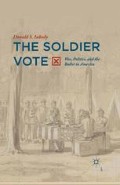Abstract
The progressive era and World War I brought about some improvement in state absentee voting laws. However, most state laws still made it difficult, if not impossible, for a deployed military person to register and cast a ballot. The passage of the 19th Amendment, which enfranchised women in 1920, marked the end of significant change in election laws and ushered in a period of stasis that would last for two decades until the beginning of World War II.2 Resistance to attempts for further changes, especially granting the right to vote to deployed soldiers and sailors, would be marked by partisan and racial rancor.
Those boys are fighting to maintain the rights of the States. Those boys are fighting to maintain white supremacy.
Senator James Eastland (D-MS), 1944.1
Access this chapter
Tax calculation will be finalised at checkout
Purchases are for personal use only
Preview
Unable to display preview. Download preview PDF.
Notes
Cited in Ira Katznelson. 2013. Fear Itself: The New Deal and the Origins of Our Time. New York: Liveright Publications, 206.
Alexander Keyssar. 2000. The Right to Vote: The Contested History of Democracy in the United States. New York: Basic Books, 235.
Michael Anderson. 2001. “Politics, Patriotism, and the State: The Fight over the Soldier Vote, 1942–1944,” in Politics and Progress; American Society and the State since 186., ed. Andrew Edmund Kersten and Kriste Lindenmeyer, New York: Praeger Publishers, 86.
J. Garry Clifford and Samuel R. Spencer Jr. 1986. The First Peacetime Draft. Lawrence: University of Kansas Press; Defense Manpower Data Center, Historical Data.
See Ulysses Lee. 1966. The Employment of Negro Troops [United States Army in World War II]. Washington, DC: U.S. Government Printing Office.
Paula Giddings. 1984. When and Where I Enter: The Impact of Black Women on Race and Sex in America. New York: William Morrow, 235.
Cited in Michael Anderson. 2001. “Politics, Patriotism, and the State,” 86.
Boyd A. Martin. 1945. “The Service Vote in the Elections of 1944.” American Political Science Revie. 39 (4): 720–732;
Richard Briffault. 2002. “The Contested Right to Vote.” Michigan Law Revie. 100: 1521–1522.
Michael Anderson. 2001. “Politics, Patriotism, and the State,” 88.
Russ W. Carter. 2005. War Ballots: Military Voting by Mail from the Civil War to WWII. Cypress, TX: Military Postal History Society, 69, 75.
Carter. 2005. War Ballot., 27;
R. Michael Alvarez, Thad E. Hall, and Brian F. Roberts. 2007. “Military Voting and the Law: Procedural and Technical Solutions to the Ballot Transit Problem.” Fordham Urban Law Journa. 34(3): 935–997; Martin. 1945. “Service.”
Charles L. Maschinot. 1943. Shipswake Newsletter. USS Salt Lake Cit. CA 25.
George Gallup. 1943. “Soldiers Could Decide ’44 Election, Gallup Poll Finds,” New York Time., December 5.
Also see Martin. 1945. “Service Vote,” 720.
Franklin D. Roosevelt. 1944. “Message to Congress on Voting by Members of the Armed Forces,” January 25.
Time. 1944. “The Congress: 1944: First Issue.”. February 7.
James E. Phillips. 1944. “Letters,” Tim., January 3.
Harold Kramer. 1944. “Soldier Voters.” Yank: The Army Weekly. March 17.
George Kauffman. 1944. Yank: The Army Weekly. March 17.
Frank Bain. 1944. “Soldier Voters.” Yank: The Army Weekly. March 17.
Alvin C. Strutz. 1944. “Opinion 44–51.” Letter from Attorney General, North 37.
George Tagge. 1944. “Bar Censorship of War Ballot, State Demands.” Chicago Tribune. September 12, 8. Available at http://archives.chicagotribune.com/1944/09/12/page/8/article/bar-censorship-of-war-ballot-state-demands
Amy Heubner de Grazia, ed. 1999. Home Front and War Front in World War II: The Correspondence of Jill Openheim de Grazia and Alfred de Grazia (1942–1945). Princeton, NJ: Metron Publications, 1508.
Carter. 2005. War Ballot., 50–51.
Copyright information
© 2016 Donald S. Inbody
About this chapter
Cite this chapter
Inbody, D.S. (2016). World War II: Race and Politics. In: The Soldier Vote. Palgrave Macmillan, New York. https://doi.org/10.1057/9781137519207_5
Download citation
DOI: https://doi.org/10.1057/9781137519207_5
Publisher Name: Palgrave Macmillan, New York
Print ISBN: 978-1-349-57815-3
Online ISBN: 978-1-137-51920-7
eBook Packages: Political Science and International StudiesPolitical Science and International Studies (R0)

